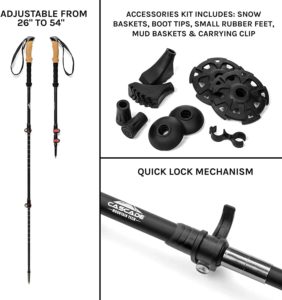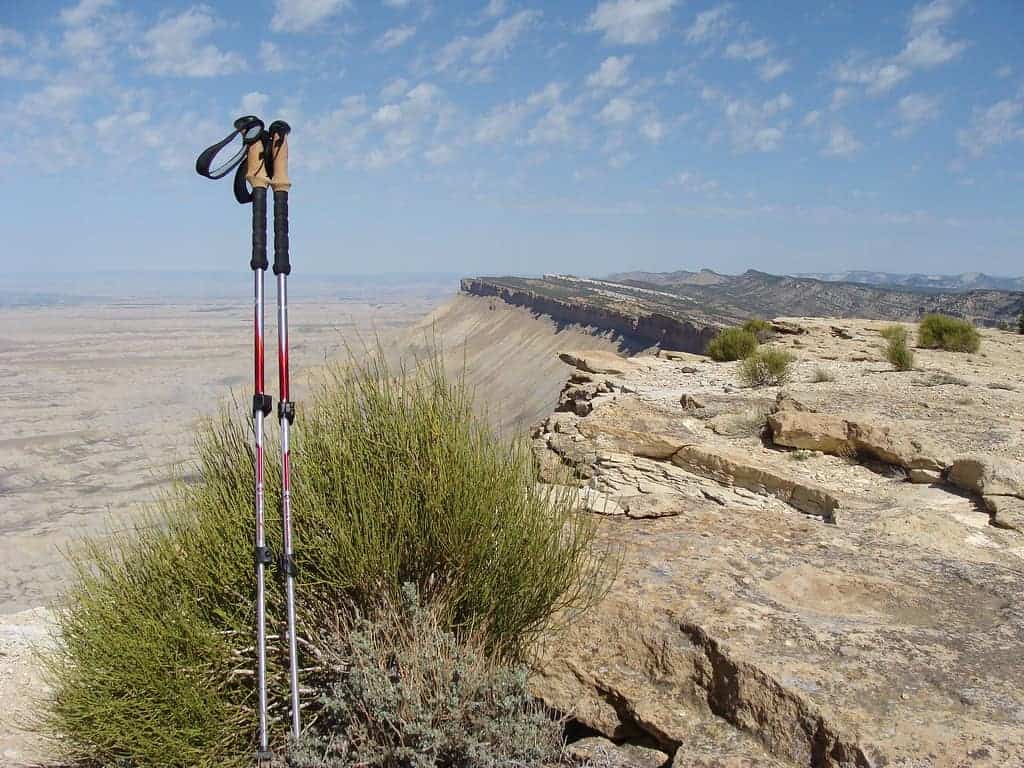Trekking Pole Length By Height
| User Height (inches) | Pole Length (inches) |
| 4’1″-4:4″ | 38 |
| 4’5″ – 4’8″ | 40 |
| 4’9″ – 5’0″ | 42 |
| 5’1″ – 5’3″ | 44 |
| 54″ – 5’6″ | 46 |
| 57″ – 5’9″ | 48 |
| 5’10” – 6’0″ | 50 |
| 6’1″ – 6’3″ | 52 |
| 6’4″ – 6’6″ | 54 |
| 6’7″+ | 56 |
Choosing Hiking Poles Depending On Size
If you’re a great outdoors lover and love taking in the sights and smells of nature and all it has to offer, you probably love hiking, cross-country skiing, or snowshoeing. There are a lot of great places to go hiking or snowshoeing, whether in the Appalachian Mountains, the Rockies, or the Pacific Coast. But when you go hiking, you usually want to have various equipment to aid you through the challenges. That equipment includes hiking boots for the appropriate terrain, a backpack that can hold your food and water, a first aid kit, and maybe your tent if you’re going to go camping, and the right size hiking poles when needed.
How to Size Hiking Poles
 Most hiking poles come in adjustable sizes to match hikers of different heights. You need to remember that poles are usually measured in centimeters, so you’ll want to convert your height into that measurement to figure out which hiking pole size you need.
Most hiking poles come in adjustable sizes to match hikers of different heights. You need to remember that poles are usually measured in centimeters, so you’ll want to convert your height into that measurement to figure out which hiking pole size you need.
But going with an adjustable pole is usually a good idea because poles typically need to be extended or shortened during a hike, even though not all hikers take the time to do this. You can use several methods for hiking pole sizing when asking yourself, “what length hiking pole do I need?”
Sizing Based On Where Your Arms Are Extended Straight Out
One easy way to figure out your hiking pole height is to hold your arms with your elbows at your sides and your forearms at 90 degrees parallel to the ground. The height from the palms of your hands to the ground is the length of the pole you want.
Taller people may want to adjust the final pole height, while shorter people may want to ease it down. Some charts make recommendations if you prefer a sizing method based more on hard numbers.
Another method for determining the correct height is getting your height in centimeters and multiplying that by 0.68. For example, if you are 6’0, the height of your poles should be about 125 cm, whereas if you are only 5’0, you’ll want to go with about 105 cm length poles. But again, you may want to adjust them up or down just a little to get the maximum comfort level.
Do I Need Hiking Poles?
Not everybody uses hiking poles. And there are some circumstances in which you may not need them or even some that could make them dangerous to use. You should consider what kind of trail you’re hiking on, what type of load you are carrying on your back, and potential obstacles you might run into along the way. Also, you might consider using hiking poles for some journeys while going without other portions.
Maintaining balance
Hikers use poles mainly to maintain balance as they go up and down hills and mountains, across streams, and through uneven ground. When you have a backpack that can make walking on that terrain difficult and need extra support, a pair of hiking poles can get the job done. But there are even a few lesser-known benefits, such as when you need to cross stepping stones on a stream. You can place the poles in the water to see how deep it is, or you can balance with them as you move from one stone to the next.
Engaging arms during hiking workout
Another great thing they can do is engage your arms while hiking to get them involved in the workout. You might find that helpful if you want to engage that part of your body while possibly taking a slight load off your legs. But your poles may even come in handy for uses other than hiking. Nobody wants to run into adversarial animals while on the trail, but you never know when you might bump into snakes, mountain lions, bears, or others. If you need to fend them off, your hiking poles are there to use.
Some downsides to using poles
Nonetheless, there are a few downsides to using poles, and in situations, you may be better off using your hands to grip a rope or objects around you. If you want to engage your body core and make sure you aren’t making it dependent on poles for its natural workout, you would be better off not using them. Also, if you’re going to be on a long trek of over 10 miles in a day, you might be better off going without them to save energy.
Some surfaces are too steep for climbing, and you might want to use your hands or climbing rope to go up or down while carrying the poles in your backpack. Others may go without them for the simple reason of not wanting any extra objects to tote or holding them back.
Other Considerations For Choosing Hiking Poles
A few hikers may find it more to their liking to use just one pole or stick when hiking, but you’re usually better off going with two. The material they’re made of also matters. Your standard outdoor sports store will usually sell them in aluminum and carbon fiber since these are generally the lightest materials. Aluminum is generally more recommended for rougher terrain because carbon fiber can break more easily.
Also, you will want comfortable grips on the poles so that your hands don’t get blistered and tired from using them. Most hiking experts recommend foam or cork since that’s generally easier on the hands than plastic. You may even want a pair of soft gloves to add more comfort to gripping the poles. If you wish for another feature for them, you might like shock absorbers, but many hikers say they don’t make much difference.
Using Them While Hiking
The general recommendation for using hiking poles is to shorten them when going uphill and lengthen them when going down. You generally want them 5-10 cm shorter when going up a steady incline and then 5-10 cm longer when going down.
It is essential to focus on stepping by shifting your weight to your forefoot and midfoot so that you aren’t straining your knees too much.
